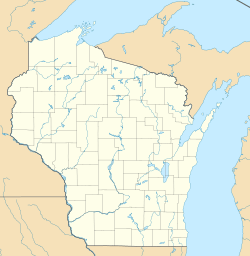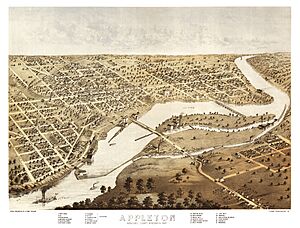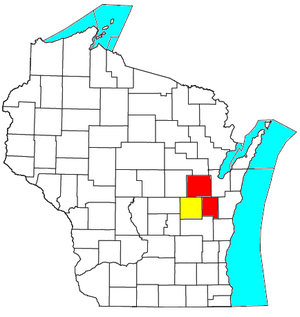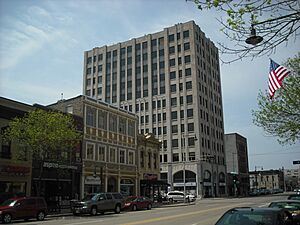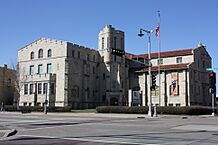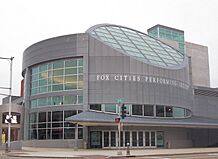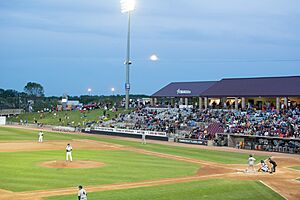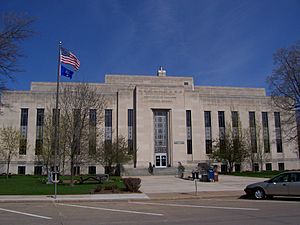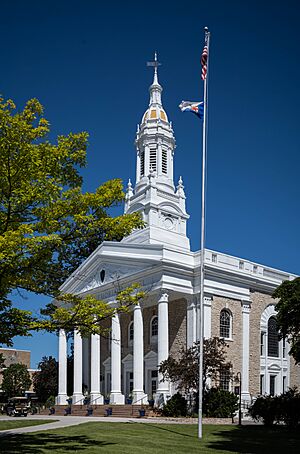Appleton, Wisconsin facts for kids
Quick facts for kids
Appleton, Wisconsin
|
|
|---|---|
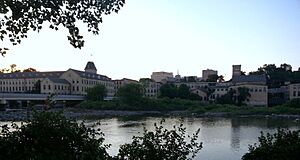
Downtown Appleton viewed from the Fox River
|
|
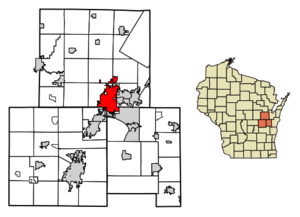
Location of Appleton in Outagamie, Calumet, and Winnebago counties, Wisconsin
|
|
| Country | |
| State | |
| Counties | Outagamie, Calumet, Winnebago |
| Settled | 1847 |
| Incorporated | 1853 (village) 1857 (city) |
| Named for | Samuel Appleton |
| Government | |
| • Type | Mayor–council |
| Area | |
| • City | 25.29 sq mi (65.49 km2) |
| • Land | 24.79 sq mi (64.20 km2) |
| • Water | 0.50 sq mi (1.29 km2) 1.97% |
| Elevation | 790 ft (240 m) |
| Population
(2020)
|
|
| • City | 75,644 |
| • Rank | 6th in Wisconsin |
| • Density | 2,989.15/sq mi (1,154.12/km2) |
| • Urban | 230,967 (US: 171st) |
| • Urban density | 2,143.0/sq mi (827.4/km2) |
| • Metro | 243,147 (US: 194th) |
| Demonym(s) | Appletonians |
| Time zone | UTC−06:00 (CST) |
| • Summer (DST) | UTC−05:00 (CDT) |
| ZIP Code |
54911, 54912, 54913, 54914, 54915, 54919
|
| Area code(s) | 920 |
| FIPS code | 55-02375 |
| GNIS feature ID | 1560914 |
| Major airport | Appleton International Airport (ATW) |
| Major Routes | |
| Public Transit | |
Appleton is a city in Wisconsin, United States. It is the main city of Outagamie County. Small parts of Appleton also reach into Calumet and Winnebago counties. The city is located on the Fox River, just north of Lake Winnebago.
Appleton is about 30 miles (48 km) southwest of Green Bay. It is also about 100 miles (160 km) north of Milwaukee. In 2020, Appleton had a population of 75,644 people. This makes it the sixth-largest city in Wisconsin. The larger Appleton metropolitan area has about 243,147 residents. Appleton is part of a bigger area known as the Fox Cities.
The city was started in the mid-1800s. It grew into an important center for industry and education. Lawrence University was founded here in 1847. Appleton's economy was first known for paper manufacturing. Today, it also has many retail businesses and healthcare services. These include St. Elizabeth Hospital and ThedaCare Regional Medical Center–Appleton. Appleton is also a cultural hub in the Fox River Valley. It has places like the Fox Cities Performing Arts Center and the History Museum at the Castle. This museum celebrates local history and famous people like the magician Harry Houdini. The city also hosts fun events like Octoberfest and the Mile of Music festival.
Contents
History of Appleton
Early Native American Life
The land where Appleton is now was once home to the Ho-Chunk and Menominee Native American tribes. The Menominee Nation gave this land to the United States in 1836. In the Menominee language, Appleton is called Ahkōnemeh. This means "watches for them place."
The first European people to settle in Appleton were fur traders. They came to trade with the Native Americans living in the Fox River Valley. One of the first buildings was the White Heron. Hippolyte Grignon built it in 1835 as a home, inn, and trading post.
How Appleton Grew
Appleton was settled in 1847. It began as three small villages along the Fox River. These villages were Grand Chute, Appleton, and Lawesburg. In 1853, they all joined together to form the Village of Appleton. John F. Johnston was the first resident and village president.
Lawrence University was also founded in 1847. It received money from Amos A. Lawrence. Samuel Appleton, Lawrence's father-in-law, gave $10,000 to the new college library. The town was named Appleton to honor his gift.
The paper industry was very important for Appleton's growth. The first paper mill was built in 1853. To power the paper mills, the nation's first hydroelectric power plant was built. This was the Vulcan Street Plant on the Fox River. It started working on September 30, 1882. This plant also powered the Hearthstone House. This was the first home in the world to get electricity from a central hydroelectric station.
Appleton was also home to other "firsts." In 1886, it had the first successful electric streetcar company. Electric lights replaced gas lamps on College Avenue in 1912. Appleton also had the first telephone in Wisconsin. It was one of the first cities outside the East Coast to have incandescent lights.
Appleton officially became a city on March 2, 1857. Amos Story was its first mayor. The city grew steadily over the years. By 1940, its population was 28,436. In the 1940s and 1950s, Appleton grew even more by adding nearby areas. These included the Glendale, Bell Heights, and Whispering Pines districts.
The 222 Building, Appleton's tallest, was built in 1952. The Valley Fair Shopping Center, built in 1954, was one of the first enclosed shopping malls in the U.S.
For a period in the past, Appleton had rules that made it difficult for certain groups of people, especially African Americans, to live or stay in the city. This was a time when many places in the U.S. had unfair practices.
Geography and Climate

Appleton covers about 24.82 square miles (64.28 km²). Most of this area is land, with a small part being water.
Appleton's Weather
Appleton has a humid continental climate. This means it has warm to hot summers and cold winters. It gets a moderate amount of rain and snow compared to other areas near the Great Lakes.
Appleton can have extreme temperatures. The hottest temperature ever recorded was 107°F (42°C) in 1936. The coldest was -32°F (-36°C) in 1929.
| Climate data for Appleton, Wisconsin (1991–2020 normals, extremes 1893–present) | |||||||||||||
|---|---|---|---|---|---|---|---|---|---|---|---|---|---|
| Month | Jan | Feb | Mar | Apr | May | Jun | Jul | Aug | Sep | Oct | Nov | Dec | Year |
| Record high °F (°C) | 55 (13) |
68 (20) |
83 (28) |
89 (32) |
95 (35) |
101 (38) |
107 (42) |
103 (39) |
101 (38) |
89 (32) |
75 (24) |
64 (18) |
107 (42) |
| Mean maximum °F (°C) | 43 (6) |
47 (8) |
64 (18) |
76 (24) |
86 (30) |
91 (33) |
92 (33) |
90 (32) |
87 (31) |
78 (26) |
62 (17) |
48 (9) |
94 (34) |
| Mean daily maximum °F (°C) | 25.4 (−3.7) |
29.1 (−1.6) |
40.6 (4.8) |
54.0 (12.2) |
67.2 (19.6) |
77.0 (25.0) |
81.5 (27.5) |
79.3 (26.3) |
71.9 (22.2) |
57.8 (14.3) |
43.4 (6.3) |
30.7 (−0.7) |
54.8 (12.7) |
| Daily mean °F (°C) | 17.7 (−7.9) |
20.4 (−6.4) |
31.4 (−0.3) |
44.0 (6.7) |
56.8 (13.8) |
66.8 (19.3) |
71.4 (21.9) |
69.5 (20.8) |
61.3 (16.3) |
48.6 (9.2) |
35.5 (1.9) |
23.8 (−4.6) |
45.6 (7.6) |
| Mean daily minimum °F (°C) | 10.0 (−12.2) |
11.7 (−11.3) |
22.1 (−5.5) |
33.9 (1.1) |
46.4 (8.0) |
56.6 (13.7) |
61.3 (16.3) |
59.8 (15.4) |
50.8 (10.4) |
39.3 (4.1) |
27.6 (−2.4) |
16.8 (−8.4) |
36.4 (2.4) |
| Mean minimum °F (°C) | −10 (−23) |
−7 (−22) |
2 (−17) |
19 (−7) |
31 (−1) |
42 (6) |
50 (10) |
47 (8) |
35 (2) |
25 (−4) |
12 (−11) |
−3 (−19) |
−14 (−26) |
| Record low °F (°C) | −30 (−34) |
−32 (−36) |
−21 (−29) |
7 (−14) |
23 (−5) |
34 (1) |
41 (5) |
35 (2) |
25 (−4) |
15 (−9) |
−7 (−22) |
−23 (−31) |
−32 (−36) |
| Average precipitation inches (mm) | 1.36 (35) |
1.13 (29) |
1.92 (49) |
3.24 (82) |
3.64 (92) |
4.65 (118) |
3.78 (96) |
3.58 (91) |
3.18 (81) |
2.84 (72) |
2.07 (53) |
1.76 (45) |
33.15 (842) |
| Average snowfall inches (cm) | 12.6 (32) |
11.2 (28) |
7.2 (18) |
4.0 (10) |
0.1 (0.25) |
0.0 (0.0) |
0.0 (0.0) |
0.0 (0.0) |
0.0 (0.0) |
0.3 (0.76) |
2.4 (6.1) |
11.6 (29) |
49.4 (125) |
| Average precipitation days (≥ 0.01 in) | 9.2 | 8.5 | 9.2 | 11.6 | 11.9 | 11.5 | 11.1 | 10.5 | 9.8 | 10.6 | 8.8 | 9.9 | 122.6 |
| Average snowy days (≥ 0.1 in) | 8.2 | 7.7 | 5.0 | 2.3 | 0.1 | 0.0 | 0.0 | 0.0 | 0.0 | 0.2 | 2.8 | 7.7 | 34.0 |
| Source: NOAA | |||||||||||||
People of Appleton
| Historical population | |||
|---|---|---|---|
| Census | Pop. | %± | |
| 1860 | 2,345 | — | |
| 1870 | 4,518 | 92.7% | |
| 1880 | 8,005 | 77.2% | |
| 1890 | 11,869 | 48.3% | |
| 1900 | 15,085 | 27.1% | |
| 1910 | 16,773 | 11.2% | |
| 1920 | 19,561 | 16.6% | |
| 1930 | 25,267 | 29.2% | |
| 1940 | 28,436 | 12.5% | |
| 1950 | 34,010 | 19.6% | |
| 1960 | 48,411 | 42.3% | |
| 1970 | 56,377 | 16.5% | |
| 1980 | 58,913 | 4.5% | |
| 1990 | 65,695 | 11.5% | |
| 2000 | 70,087 | 6.7% | |
| 2010 | 72,623 | 3.6% | |
| 2020 | 75,644 | 4.2% | |
| U.S. Decennial Census | |||
Appleton is the main city of the Appleton–Oshkosh–Neenah CSA. This is a larger area that includes Appleton and Oshkosh–Neenah. In 2010, this combined area had 392,660 people. By 2019, it was estimated to have 409,881 residents.
In 2020, Appleton's population was 75,644. Most people lived in Outagamie County (62,899). Others lived in Calumet County (11,304) and Winnebago County (1,441).
Population Details
In 2020, about 7.3% of the city's population was Hispanic or Latino. Looking at race, 80.1% of people were White. About 6.4% were Asian, and 3.13% were Black or African American.
The average income for a household in Appleton was $61,475 between 2016 and 2020. For families, it was $76,791. About 10.3% of the population lived below the poverty line. This included 15.8% of those under 18 years old. Most adults (92.6%) had finished high school or more. About 33.6% had a bachelor's degree or higher.
Hmong Community
Appleton has a notable Hmong community. In 2022, there were 2,965 Hmong people living in the city. This group makes up over 70% of Appleton's Asian population.
Economy and Jobs
Appleton has a strong economy with many different types of jobs. As of 2020, some of the largest employers in the city included:
- St. Elizabeth Hospital/Ascension Health (5,172 employees)
- Thrivent Financial (2,000 employees)
- Appleton Area School District (1,918 employees)
- Miller Electric (1,400 employees)
- ThedaCare Regional Medical Center–Appleton (1,184 employees)
Several companies have their main offices in Appleton. These include ASP, Inc., Fleet Farm, and Miller Electric.
Healthcare Services
Appleton has two main hospitals that serve the community:
- ThedaCare Regional Medical Center–Appleton
- St. Elizabeth Hospital
Arts and Culture
Appleton offers many fun places to visit. The Hearthstone Historic House Museum is a four-story house. It was the first home in the U.S. to be powered by hydroelectricity in 1881. The History Museum at the Castle shows exhibits about the Fox River Valley's past. It has a special area for magician Harry Houdini.
The Fox Cities Exhibition Center is a large place for events and meetings. The Fox Cities Performing Arts Center hosts many shows. These include theater, music, and dance. The Gardens of the Fox Cities is a public garden. It shows off the beautiful plants of Wisconsin. The Trout Museum of Art displays various art exhibits.
Houdini Plaza is a popular spot downtown. It hosts about 55 events each year. These include summer concerts and part of the downtown farmers market.
The Atlas Science Center used to be the Paper Discovery Center. It was a museum about papermaking and the history of the paper industry. It closed in November 2024.
Parks and Recreation
Appleton has many parks for everyone to enjoy. The city has 24 neighborhood parks and four larger community parks. Neighborhood parks are usually 2 to 16 acres in size. Community parks are larger, from 25 to 139 acres. Goodland Field is a historic baseball site. The Neuroscience Group Field at Fox Cities Stadium is home to the Wisconsin Timber Rattlers minor league baseball team.
Memorial Park is the biggest community park, covering 139 acres. It has baseball/softball fields, playgrounds, and an indoor ice skating rink. There's also a sledding hill, picnic areas, and a fishing pond. The park hosts a big fireworks show for the 4th of July.
City Park is the oldest park in Appleton, started in 1882. The Trout Museum of Art holds its Art in the Park event here. This show features over 200 artists and attracts many art lovers. Pierce Park hosts weekly Appleton City Band concerts in the summer. It also has the annual Appleton Old Car Show. Pierce Park and Telulah Park both have disc-golf courses. Erb Park and Mead Park have public swimming facilities. Jones Park is the finish line for the Santa Scamper run during the annual Appleton Christmas Parade. It also has an outdoor hockey rink in winter.
City Government
Appleton is run by a mayor and a city council. The mayor chooses people to lead city departments. The city council must approve these choices. The city attorney is elected every four years. The city council has 15 members, called alderpersons. They are elected for two-year terms from different areas of the city.
The current mayor of Appleton is Jake Woodford. He was elected in 2020. The first mayor was Amos Story, elected in 1857. Timothy Hanna was the longest-serving mayor. He served from 1996 to 2020.
Mayors of Appleton
Here is a list of some of Appleton's past mayors:
| Order | Term start | Term end | Mayor | Notes |
|---|---|---|---|---|
| 1 | 1857 | 1859 | Amos Story | |
| 2 | 1859 | 1860 | Alvin Foster | |
| 3 | 1860 | 1862 | Robert R. Bateman | |
| 4 | 1862 | 1865 | William Johnson | |
| 5 | 1865 | 1866 | R. Z. Mason | |
| 6 | 1866 | 1867 | James Gilmore | |
| 7 | 1867 | 1868 | Robert R. Bateman | |
| 8 | 1868 | 1870 | George N. Richmond | |
| 9 | 1870 | 1871 | Augustus L. Smith | |
| 10 | 1871 | 1872 | George N. Richmond | |
| 11 | 1872 | 1873 | E. C. Goff | |
| 12 | 1873 | 1875 | S. R. Willy | |
| 13 | 1875 | 1875 | Peter Esselburn | |
| 14 | 1875 | 1877 | J. E. Harriman | |
| 15 | 1877 | 1878 | Joseph H. Marston | |
| 16 | 1878 | 1879 | James Ryan | |
| 17 | 1879 | 1880 | Orson W. Clark | |
| 18 | 1880 | 1882 | Humphrey Pierce | |
| 19 | 1882 | 1883 | Joseph H. Marston | |
| 20 | 1883 | 1887 | G. N. Richmond | |
| 21 | 1887 | 1889 | Rush Winslow | |
| 22 | 1889 | 1892 | Alfred H. Levings | |
| 23 | 1892 | 1893 | Rush Winslow | |
| 24 | 1893 | 1894 | Humphrey Pierce | |
| 25 | 1894 | 1897 | Peter Thom | |
| 26 | 1897 | 1900 | Herman Erb Jr. | |
| 27 | 1900 | 1904 | David Hammel | |
| 28 | 1904 | 1906 | Frank W. Harriman | |
| 29 | 1906 | 1908 | David Hammel | |
| 30 | 1908 | 1910 | Bernard C. Wolter | |
| 31 | 1910 | 1913 | James V. Canavan | Died in office, Dec. 1913. |
| 32 | 1914 | 1917 | August Knuppel | Won Feb. 1914 special election. |
| 33 | 1917 | 1918 | John Faville | |
| 34 | 1918 | 1922 | J. Austin Hawes | |
| 35 | 1922 | 1924 | Henry Reuter | |
| 36 | 1924 | 1926 | John Goodland Jr. | |
| 37 | 1926 | 1930 | Albert Rule | |
| 38 | 1930 | 1946 | John Goodland Jr. | |
| 39 | 1946 | 1958 | Robert Roemer | |
| 40 | 1958 | 1966 | Clarence Mitchell | |
| 41 | 1966 | 1972 | George Buckley | |
| 42 | 1972 | 1980 | James Sutherland | |
| 43 | 1980 | 1992 | Dorothy Johnson | |
| 44 | 1992 | 1996 | Richard DeBroux | |
| 45 | 1996 | 2020 | Timothy Hanna | |
| 46 | 2020 | Current | Jake Woodford |
Government Representation
Appleton is represented in the United States Senate by Ron Johnson and Tammy Baldwin. In the United States House of Representatives, Appleton is represented by Tony Wied. He has represented Wisconsin's 8th district since November 2024.
Education in Appleton
The Appleton Area School District serves the city. It has three high schools, four middle schools, and seventeen elementary schools. There are also sixteen charter schools. The main public high schools are Appleton East, Appleton North, and Appleton West.
Appleton also has private high schools. These include the Catholic Xavier High School and Fox Valley Lutheran High School. There are also charter high schools like Fox Cities Leadership Academy and Tesla Engineering.
Lawrence University, a private liberal arts college, is in Appleton. Fox Valley Technical College is also located here. Other colleges like Concordia University Wisconsin have branch campuses in the city.
Appleton is becoming a leader in technology education for kids. The Appleton Youth Education Initiative works with big companies like Microsoft and Plexus Corp. They organize events like the Appleton Tech Clinic and HackAppleton. HackAppleton is a popular annual event where students create new tech projects.
The Appleton Public Library serves the city and nearby areas. It started in 1897. As of 2010, it has over 600,000 items. The library offers free Wi-Fi and other services.
Transportation and Infrastructure
Getting Around Appleton
The city owns Valley Transit, which is a bus system for the Fox Valley area. For travel to other cities, you can use Amtrak Thruway or Lamers Bus Lines. These go to places like Green Bay, Madison, and Chicago.
In April 2021, electric scooters became available for rent in Appleton. However, the city ended its partnership with the scooter company in 2024.
Major roads that go through Appleton include:
- Interstate 41
- US 10
- US 41
- WIS 47
- WIS 96
- WIS 125
- WIS 441
Railways
Appleton has several railway lines. These were once main lines for different railway companies. Now, all train services are run by Canadian National Railway. Appleton does not have passenger train service for travel between cities. However, studies are looking into bringing Amtrak service to the Fox Cities and Green Bay.
Airport Access
The Appleton International Airport is about 6 miles (9.7 km) west of downtown Appleton. It has four major airlines. The airport serves over one million passengers each year.
Famous People from Appleton
Sister Cities
Appleton has "sister city" relationships with two other cities around the world:
 Chinandega, Chinandega Department, Nicaragua
Chinandega, Chinandega Department, Nicaragua Kan'onji, Kagawa, Japan
Kan'onji, Kagawa, Japan
See also
 In Spanish: Appleton (Wisconsin) para niños
In Spanish: Appleton (Wisconsin) para niños


